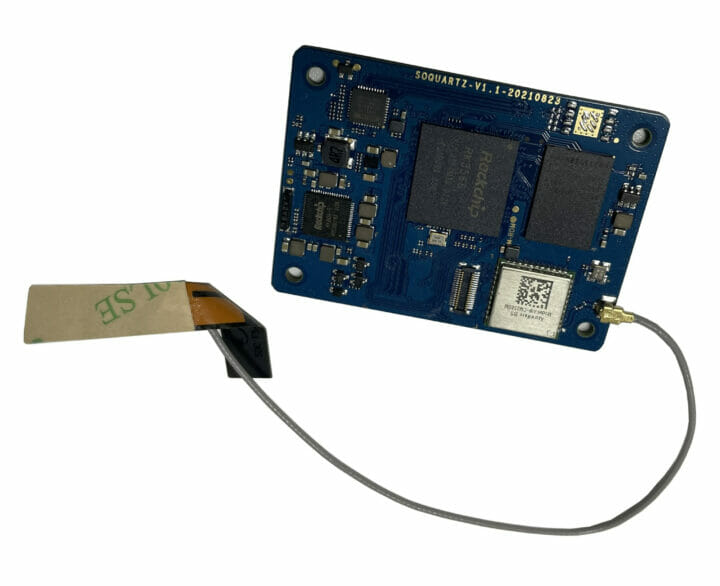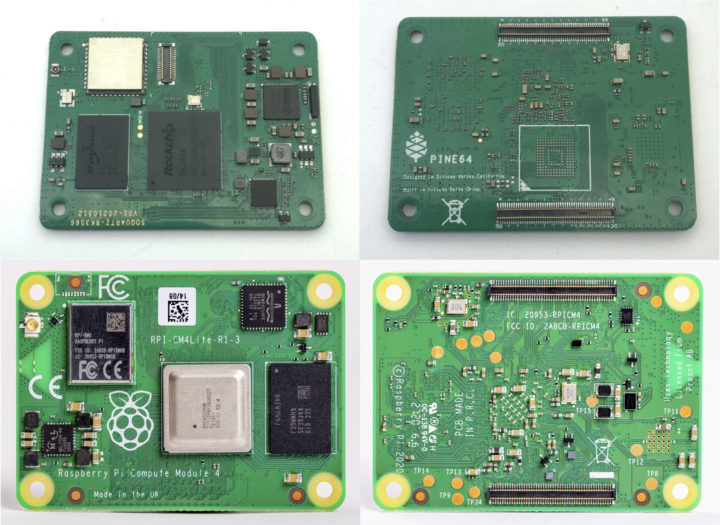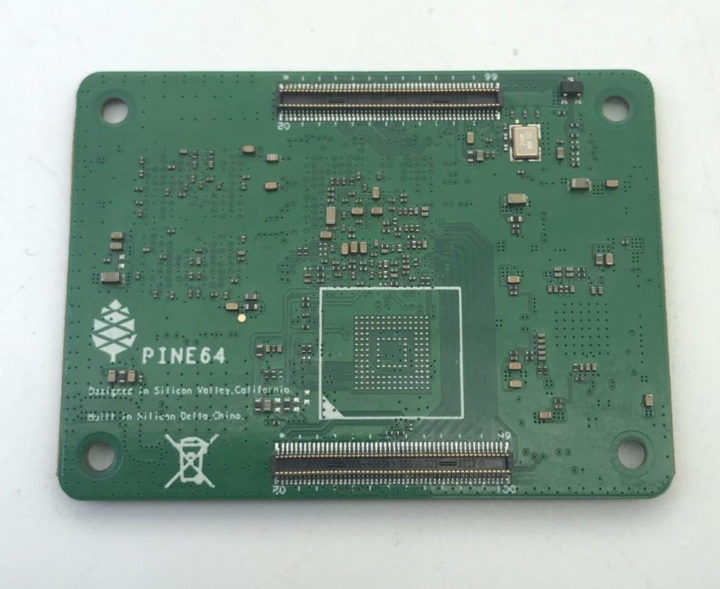Radxa CM3 Raspberry Pi 4 alternative was just introduced yesterday, but today, Pine64 SOQuartz Compute Module has just become available for $34.99 and up.
Pine64 announced the Raspberry Pi Compute Module 4 compatible Rockchip RK3566 system-on-module (SoM) last June, and today the company/community launched three SOQuartz models with a wireless module and equipped with either 2GB, 4GB, or 8GB RAM.
 SOQuartz system-on-module preliminary specifications:
SOQuartz system-on-module preliminary specifications:
- SoC – Rockchip RK3566 quad-core Cortex-A55 processor up to 1.8 GHz with 32-bit RISC-V MCU, Arm Mali-G52 GPU supporting OpenGL ES 1.1/2.0/3.2, OpenCL 2.0, Vulkan 1.1, 0.8 TOPS NPU for AI acceleration
- System Memory – 2GB to 8GB LPDDR4
- Storage
- Optional 128 Mbit SPI flash
- Optional eMMC module from 16GB up to 128GB capacity or soldered-on eMMC module (see bottom of board)
- Wireless module – Azurewave AW-CM256SM WiFi 5 802.11ac & Bluetooth 5.0 wireless module plus an u.FL antenna connector.
- 2x 100-pin high-density board-to-board connectors with:
- Video Output
- 1x HDMI 2.0 interface up to 4Kp60
- 1x 2-lane MIPI DSI display interface
- 1x 4-lane MIPI DSI display interface
- Embedded DisplayPort (eDP)
- Camera I/F
- 1x 2-lane MIPI CSI camera interface
- 1x 4-lane MIPI CSI camera interface
- Ethernet – Gigabit Ethernet
- USB – 1x USB 2.0 host
- SATA III or PCIe (multiplexed)
- 28x user GPIO (3.3v or 1.8v) also configurable as 6x UART, 6x I2C, 5x SPI, SDIO, 1x DPI (Parallel RGB Display), 1x PCM, 2x PWM, 3x GPCLK outputs
- Video Output
- Supply Voltage – 5V
- Dimensions – 55 x 40 x 4.7mm with 4x M2.5 mounting holes
The module currently supports Android 11 and a Linux 4.19 BSP with download links and partial hardware specs listed on the wiki. There’s also a SOQuartz Model-A Baseboard, but it does not seem available at this time, so you’d have to rely on carrier board for the Raspberry Pi CM4 to get started. Note that software development is progress as Pine64 states:
The SOQuartz Compute Module software is still in an early development stage, and therefore only suitable for developers and advanced users wishing to contribute to software development. Both mainline and Rockchip’s BSP fork of Linux have already been booted on the platform and development is proceeding quickly, but it will be months before end-users and industry partners can reliably deploy it.
The advantages of SOQuartz over RPi CM4 Compute Module are the presence of an AI accelerator, optional 128Mbit SPI flash onboard, flexibility for the eMMC flash (module or soldered on), and support for SATA that should be multiplex with the PCIe 2.1 interface assuming they used the Multi-PHY2 interface from the processor. However, the Raspberry Pi Compute Module 4 has two HDMI interfaces, and the RK3566 module should only have one with the pins remaining unused. SOQuartz does not come with an extra 100-pin board-to-board connector provided on the Radxa CM4 module to benefit from the extra interfaces made available by the Rockchip processor.

Pine64 says SOQuartz will be software compatible with Quartz64 single board computers meaning support for Linux distributions and Android. It’s still early and a lot of work needs to be done. In theory, the module should be a drop-in replacement into Raspberry Pi CM4 carrier boards, but practice may get in the way for some of the boards, and incompatibilities are not impossible.
You can order the modules directly on Pine64 store with the 2GB RAM version going for $34.99, the 4GB model for $49.99, and you’d have to spend $74.99 to get 8GB RAM.
Update: The post was initially published on the 15th of June 2021, and updated on the 8th of November with SOQuartz becoming available to developers

Jean-Luc started CNX Software in 2010 as a part-time endeavor, before quitting his job as a software engineering manager, and starting to write daily news, and reviews full time later in 2011.
Support CNX Software! Donate via cryptocurrencies, become a Patron on Patreon, or purchase goods on Amazon or Aliexpress





